Assessment in schools often feels like judging a book by its cover – it never quite captures the whole story. Especially when every student is a unique individual with their own stories and strengths. One might even wonder if reducing people in their early, and most formative years, to letters and numbers has given rise to the self-help industry that in 2022 was valued at $13.2 billion dollars, with a compound annual growth rate of 5.6%! If you’ve ever been in a webinar with Tony Robbins, Gary Vaynerchuk, or Dean Graziosi you know that the number one thing most people are looking to hear someone say is:
“You’re good enough. You can do this. You are capable of more than you’ve been told.”
It makes me wonder:
How might we shift the educational narrative to consistently remind kids of their strengths, echoing Joe Erpelding’s sentiment: “Let’s focus on what’s strong with you, not what’s wrong with you.”
TweetHow to Turn Assignments into Portfolio-Ready Projects Using AI
Who Do You Want to Be?
In Atomic Habits James Clear shares that if we want to change the way we do things, we have to focus on identity not outcomes. The first step to doing this he says is asking,
“Who do you want to be in your role?”
It’s a question I open with when facilitating keynotes and workshops on artificial intelligence (AI) in education. When I ask people this question, I’ve never heard someone say, “Well, I’m aiming to be the Sherlock Holmes of plagiarism!” or “My big dream? Making sure every student aces those standardized tests!” Instead people share qualities that are uniquely human.

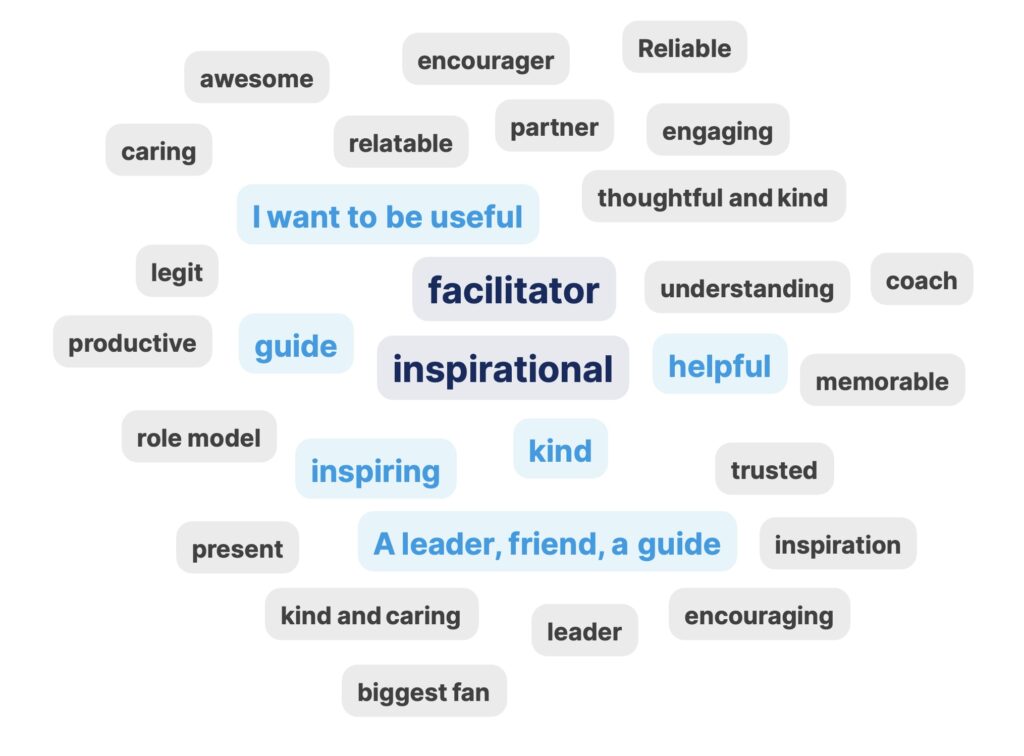
What Skills Do We Need in a World with Artificial Intelligence
Imagine a world where introductions aren’t about grades or schools, but about passions and projects. In a world evolving with AI, deeper learning skills are no longer optional; they’re essential. They’re the bridge between traditional academics and real-world applications. These skills include critical thinking, problem-solving, creativity, collaboration, communication, and self-regulation. These are also known as deeper learning skills, as they enable students to transfer their learning to new situations and domains. Last week, in this post, I shared how we did this a decade ago (that’s right 10 years ago!) with students at the University of Southern California. Research has shown that deeper learning skills are essential for students to adapt to the changing demands of the workforce and society.
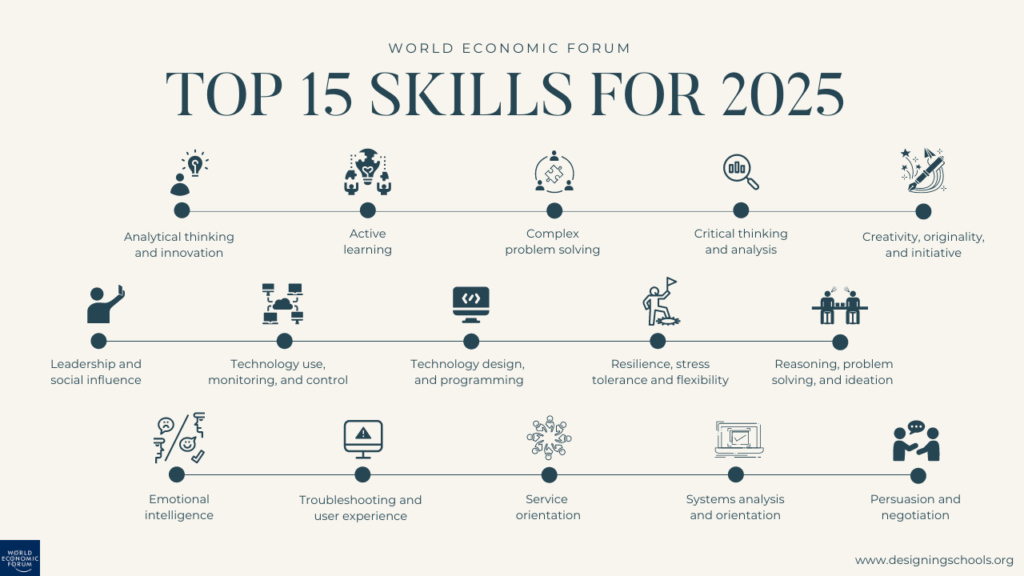
While it may not be immediately apparent, generative AI tools like ChatGPT, Bing, Bard, and others, afford us the opportunity to spend more time being who we want to be. We can all agree that traditional forms of assessment, such as standardized tests and quizzes, often fail to capture the full range of skills and knowledge that students need to succeed in the 21st century.
In today’s fast-paced world, these skills carry more weight than traditional grades.
So imagine if every student introduced themselves by saying:
- Hi! I’m ____ and I’m working on _____.
Instead of:
- Hi, I’m a freshman and I go to [insert school name].
Do you notice the difference? Such a shift in introduction isn’t just about semantics; it’s a reflection of a deeper transformation in how we perceive education and who we want to be in the age of AI.
Using Canva to Have Students Showcase Their Learning
I tested this idea last month when I facilitated a workshop for high school students from the Los Angeles Unified School District (LAUSD) hosted by the Iovine and Young Academy at the University of Southern California (USC). Jimmy Iovine and Andre Young (Dr. Dre) created a department that offers Bachelors and Masters degrees at the intersection of human-centered design, technology, entrepreneurship, and communication. Last year they launched the Iovine and Young Academy for high school students as part of LAUSD. Each summer the school hosts an innovation camp for high school students. In my workshop the goal was to help students create a portfolio showcasing their work and the process they engaged in during their time in the summer camp.
Last year Canva launched websites, so we decided to use that to have students create their portfolios. Not only is Canva free for students and educators, its intuitive interface and templates made it easy for students to see what was possible. The workshop was designed around the four competencies we share at Designing Schools when helping students create portfolios – self awareness, goal setting, professional networks, and public speaking. Ultimately we want students to be able to showcase their work, and articulate their strengths, goals and experiences with confidence. At Designing Schools we teach students that at its core, a portfolio is a relationship building tool. After just 3 hours together, students had a rough draft of a portfolio, and these reflections to share:
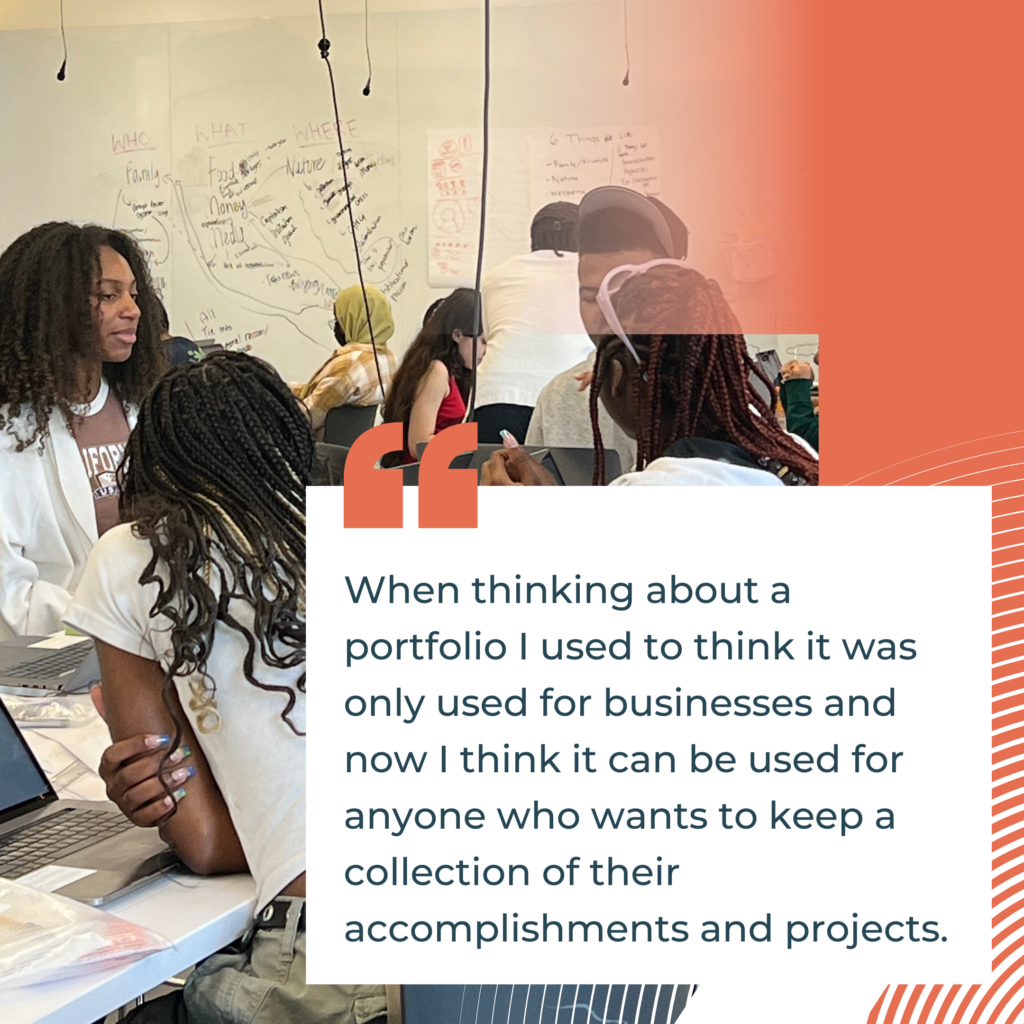
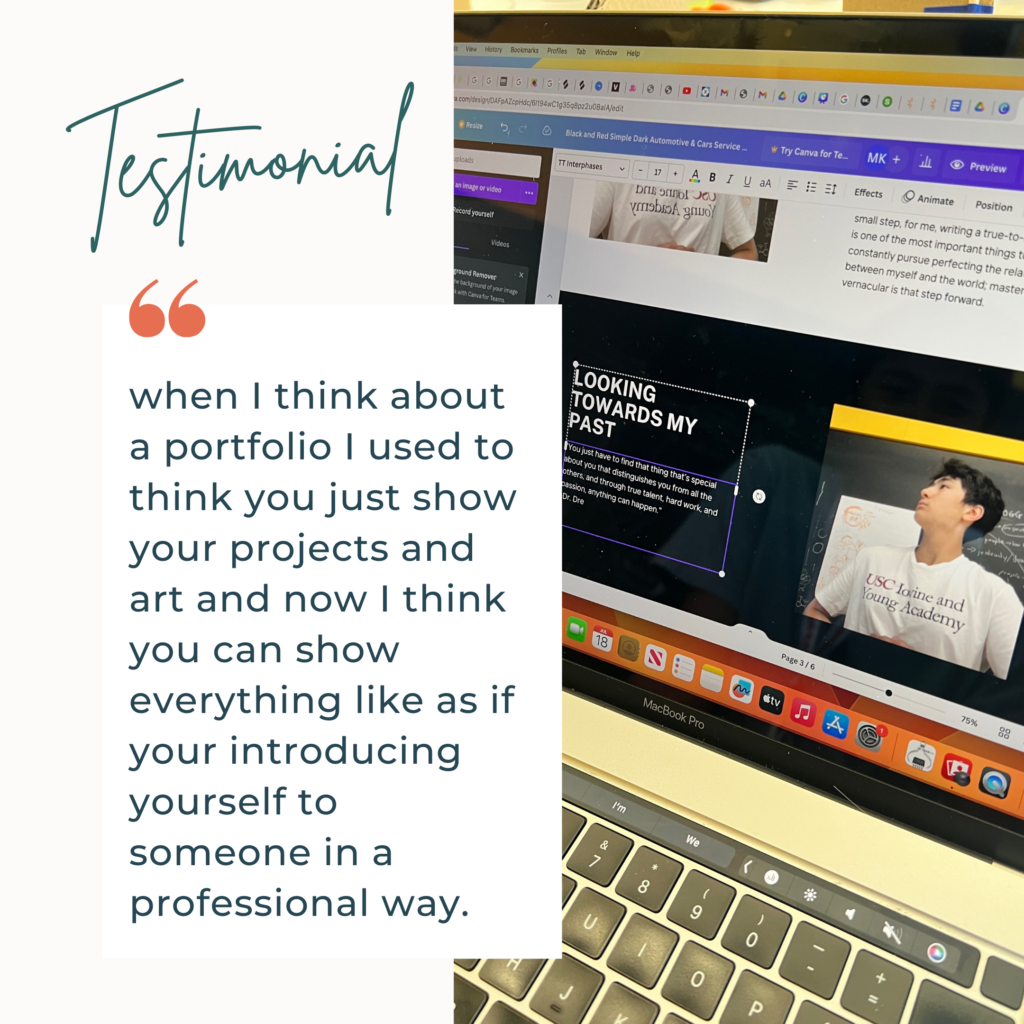

Overcoming Two Mindset Barriers to Creating a Portfolio
In my work with schools, I’ve found something interesting. The challenges aren’t always about the newest technology tools or the latest teaching methods. It’s often about mindset, and our own limiting beliefs. When we guide students in building their portfolios, two common mindset challenges stand out:
- Students struggle to articulate their own stories. It’s not always easy to put oneself on paper.
- Deciding what to highlight becomes another puzzle as most assignments aren’t “portfolio-ready.”
To solve the first challenge we begin by having students take the Sparketype – a free assessment where they learn more about what energizes them in the work they do. Understanding your strengths and what makes you unique is the foundation of a great portfolio. They share the Sparketype results with their team and then share stories about the qualities they saw in each other over the past few weeks in working on the project together. Oftentimes these are qualities that students do not share about themselves, so it’s a beautiful moment as they hear their peers share, and often validate how they feel.
To solve the second challenge I’m going to share how we can SPARK ideas for using AI to turn any assignment into a portfolio ready project.
From Traditional Standards to Portfolio Ready Projects
The journey from traditional, standards-based instruction to dynamic, portfolio-ready projects isn’t just about adding more tech or flashy tools. It’s a deeper shift in how we view education. Instead of merely transmitting knowledge, it’s about creating spaces where students actively engage, explore, and showcase their learning. One major roadblock for many educators is the time and effort this transition demands. However, with AI tools like ChatGPT today, educators have a thought partner, a helper, to make this shift smoother and more intuitive.
I created the SPARK framework to help people design prompts that encourage people to first think about the problem they want to solve, or the opportunity they are interested in to help us achieve our goals and outcomes.

As Don Norman shares, “A brilliant solution to the wrong problem can be worse than no solution at all: solve the correct problem.”
As I listen to the conversations about AI in Education, I see fear as a mindset barrier, making things much harder than perhaps they need to be. I encourage you to cut and paste these prompts below into an AI tool like ChatGPT (user4, not 3.5), and compare and contrast the results when using Microsoft Bing, Google Bard, or Anthropic’s Claude.
Let’s look at two examples of using the SPARK (Situation, Task, Action, Result, Kismet) method to turn a traditional standard into a portfolio ready project.
Situation:
Hey ChatGPT, I teach middle school science in California and I need your help coming up with ideas. We’re diving into the NGSS standard MS-ESS3-3: “Apply scientific principles to design a method for monitoring and minimizing a human impact on the environment.”
Problem:
I’ve typically used textbook readings and diagrams. But as AI reshapes our world, I’m passionate about equipping my students with skills that make them standout thinkers and problem solvers.
Aspiration:
Every headline about climate change reinforces my commitment. Using design thinking and UDL, I dream of guiding my students to craft real-world environmental solutions. I want them to feel they’re contributing meaningfully, even in a tech-driven age.
Result:
My dream outcome? By semester’s end, I hope to see every student proudly showcase their environmental solutions in their portfolios. These projects won’t just be badges of academic achievement; they’ll be proof of their readiness to tackle future challenges, making them invaluable assets when they think about their next educational and career steps.
Let ChatGPT share responses then it’s time for the last part of the SPARK – Kismet:
Kismet (the surprise):
What is something I haven’t considered that will enhance this experience?
In another example:
Situation:
Hey ChatGPT, I teach high school Social Students in California and I need your help coming up with ideas. Our focus is on standard 11.1 from the California History-Social Science Content Standards, which discusses the nation’s foundational events.
Problem:
While I’ve traditionally had students do essays and presentations, the present-day challenges, from AI ethics to debates about democracy, make me want our historical teachings to resonate more deeply. I want my students to see the bridge between then and now, especially as they prepare for a future where AI plays a significant role.
Aspiration:
Each debate on democracy and human rights emphasizes the need to understand our roots. I envision a project where students craft digital campaigns that bring the Declaration of Independence into today’s context. It’s about making history tangible, especially in our algorithm-influenced world.
Result:
My ultimate goal is that I hope to see these reinterpretations become more than just classroom projects. I want them to spark broader discussions and find a prominent place in each student’s portfolio. But beyond the project itself, these portfolios will highlight their critical thinking, adaptability, and their knack for drawing contemporary insights from historical contexts. As the world evolves, these are the skills colleges and future workplaces are hungry for. And with these portfolio pieces, our students are not just showcasing work, but essential skills that set them up for success in the future.
Let ChatGPT share responses then it’s time for the last part of the SPARK – Kismet:
Kismet (the surprise):
What is something I haven’t considered that will enhance this experience?
What Ideas Will You SPARK?
Leveraging the SPARK method, especially when paired with AI tools like ChatGPT, offers educators a dynamic toolkit. It’s not just about integrating esteemed frameworks like UDL, Design Thinking, or Backwards Design. It’s about blending these methods with our deepest aspirations for our students. This approach not only aligns with traditional standards but also nurtures essential skills and amplifies student voices. By doing so, we’re shaping learners who stride into today’s world not just as participants, but as curious, confident trailblazers.


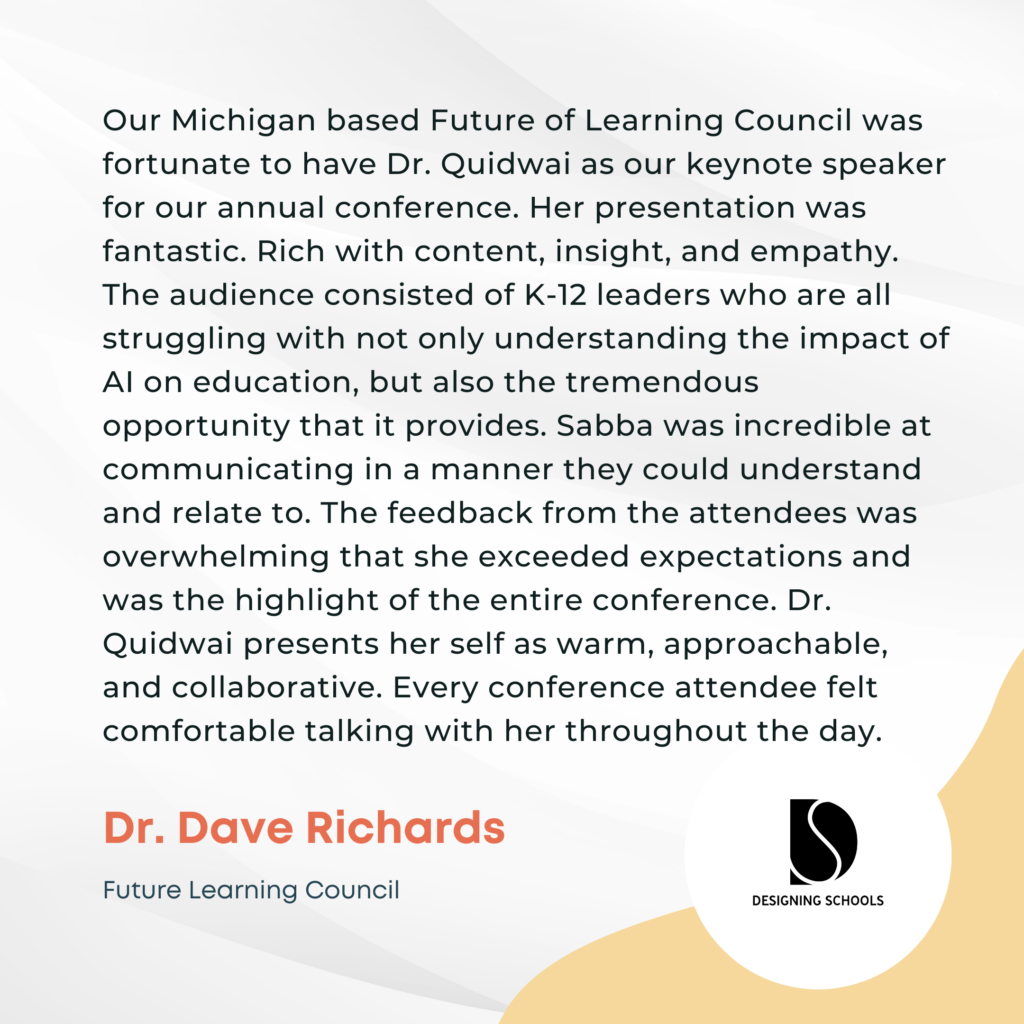
I’m Sabba.
I believe that the future should be designed. Not left to chance.
Over the past decade, using design thinking practices I've helped schools and businesses create a culture of innovation where everyone is empowered to move from idea to impact, to address complex challenges and discover opportunities.
stay connected
designing schools